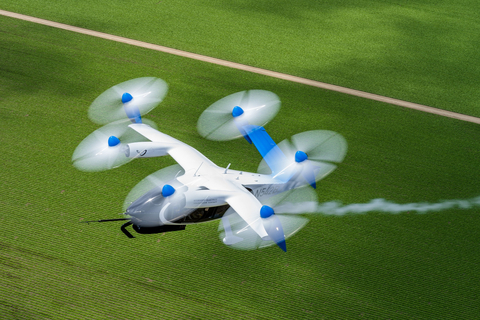Joby Demonstrates Potential for Emissions-Free Regional Journeys With Landmark 523-Mile Hydrogen-Electric Flight
- Hydrogen-electric program builds on technology developed by Joby subsidiary H2Fly, acquired in 2021, and forms part of Joby’s future technology roadmap
- Joby’s hydrogen-electric, vertical take-off and landing demonstrator aircraft completes landmark 523 mile flight, with water as the only by-product
- Flight demonstrates potential for emissions-free regional travel
-
Hydrogen-electric program supported through Joby’s partnership with the
U.S. Air Force’s Agility Prime program

On June 24, 2024, Joby’s hydrogen-electric technology demonstrator aircraft completed a 523-mile flight above
JoeBen Bevirt, Founder and CEO, Joby, said: “Traveling by air is central to human progress, but we need to find ways to make it cleaner. With our battery-electric air taxi set to fundamentally change the way we move around cities, we’re excited to now be building a technology stack that could redefine regional travel using hydrogen-electric aircraft.
“Imagine being able to fly from
“The vast majority of the design, testing and certification work we’ve completed on our battery-electric aircraft carries over to commercializing hydrogen-electric flight. In service, we also expect to be able to use the same landing pads, the same operations team, and Joby’s ElevateOS software that will support the commercial operation of our battery-electric aircraft.”
The landmark test flight, believed to be the first forward flight of a vertical take off and landing aircraft powered by liquid hydrogen, was completed last month using a converted Joby pre-production prototype battery-electric aircraft fitted with a liquid hydrogen fuel tank and fuel cell system. It landed with
Jacob Wilson, (Acting) Branch Chief, AFWERX Agility Prime, said: "Agility Prime has been very supportive of hydrogen-powered aircraft development and testing as it aligns with the program’s goals to advance transformative vertical lift technologies and broader Department of Defense operational energy goals of energy substitution and diversification, and energy demand reduction."
"Joby is a stellar example of why
Joby’s hydrogen-electric demonstrator is part of the Company’s future technology program and is the result of several years of collaboration between a small team at Joby and H2FLY, Joby’s wholly-owned subsidiary based in
Using the same airframe and overall architecture as Joby’s core, battery-electric aircraft, this demonstrator features a liquid hydrogen fuel tank, designed and built by Joby, which stores up to 40 kilograms of liquid hydrogen, alongside a reduced mass of batteries. Hydrogen is fed into a fuel cell system, designed and built by H2FLY, to produce electricity, water, and heat. The electricity produced by the hydrogen fuel cell powers the six electric motors on the Joby aircraft, with the batteries providing additional power primarily during take-off and landing.
Joby’s H2FLY team used similar technology to complete another record-breaking flight in September 2023, when they flew the world’s first piloted flight of a conventional liquid hydrogen-electric aircraft using their fuel cell technology.
As part of Joby’s wider commitment to leading the way on the development of new aviation technologies, it recently acquired Xwing Inc., an industry leader in the development of autonomous technology for aviation. Xwing has been flying autonomous aircraft since 2020, with 250 fully autonomous flights and more than 500 auto-landings completed to date, using the Superpilot software it developed in-house.
Joby plans to start commercial operations as soon as 2025, using its battery-electric air taxi. The Company is listed on the New York Stock Exchange and has raised more than
Media assets, including photos and footage of Joby’s hydrogen-electric technology demonstrator aircraft, are available here.
About Joby
Joby Aviation, Inc. (NYSE:JOBY) is a
Forward Looking Statements
This press release contains “forward-looking statements” within the meaning of the “safe harbor” provisions of the Private Securities Litigation Reform Act of 1995, including but not limited to, statements regarding the development and performance of our aircraft, the growth of our manufacturing capabilities, our regulatory outlook, progress and timing, including our expectation to start commercial air taxi operations as soon as 2025; our planned operations with the Department of Defense; our business plan, objectives, goals and market opportunity; potential benefits of, and use cases for, hydrogen-electric aircraft; the markets in which we expect to operate or sell our aircraft; and our current expectations relating to our business, financial condition, results of operations, prospects, capital needs and growth of our operations, including the expected benefits of our vertically-integrated business model. You can identify forward-looking statements by the fact that they do not relate strictly to historical or current facts. These statements may include words such as “anticipate”, “estimate”, “expect”, “project”, “plan”, “intend”, “believe”, “may”, “will”, “should”, “can have”, “likely” and other words and terms of similar meaning in connection with any discussion of the timing or nature of future operating or financial performance or other events. All forward looking statements are subject to risks and uncertainties that may cause actual results to differ materially, including: our ability to launch our air taxi service and the growth of the urban air mobility market generally; our ability to produce aircraft that meet our performance expectations in the volumes and on the timelines that we project; unknown demand, performance characteristics and certification requirements for hydrogen-electric aircraft; the competitive environment in which we operate; our future capital needs; our ability to adequately protect and enforce our intellectual property rights; our ability to effectively respond to evolving regulations and standards relating to our aircraft; our reliance on third-party suppliers and service partners; uncertainties related to our estimates of the size of the market for our service and future revenue opportunities; and other important factors discussed in the section titled “Risk Factors” in our Annual Report on Form 10-K, filed with the Securities and Exchange Commission (the “SEC”) on February 27, 2024, and in future filings and other reports we file with or furnish to the SEC. Any such forward-looking statements represent management’s estimates and beliefs as of the date of this release. While we may elect to update such forward-looking statements at some point in the future, we disclaim any obligation to do so, even if subsequent events cause our views to change.
View source version on businesswire.com: https://www.businesswire.com/news/home/20240711864329/en/
Investors:
investors@jobyaviation.com
Media:
press@jobyaviation.com
Source: Joby Aviation, Inc.








